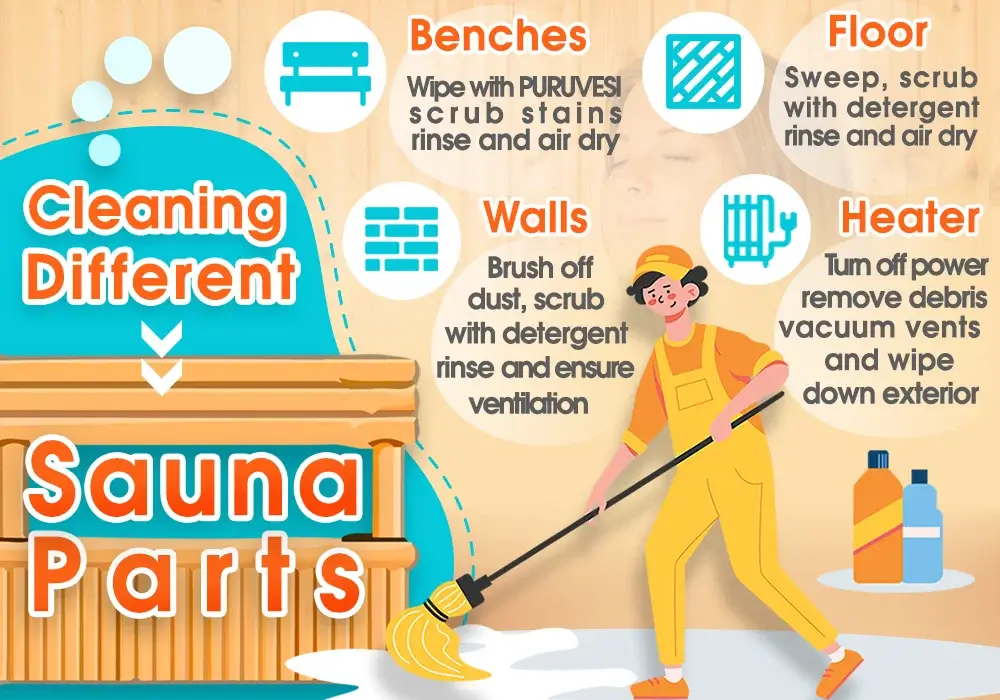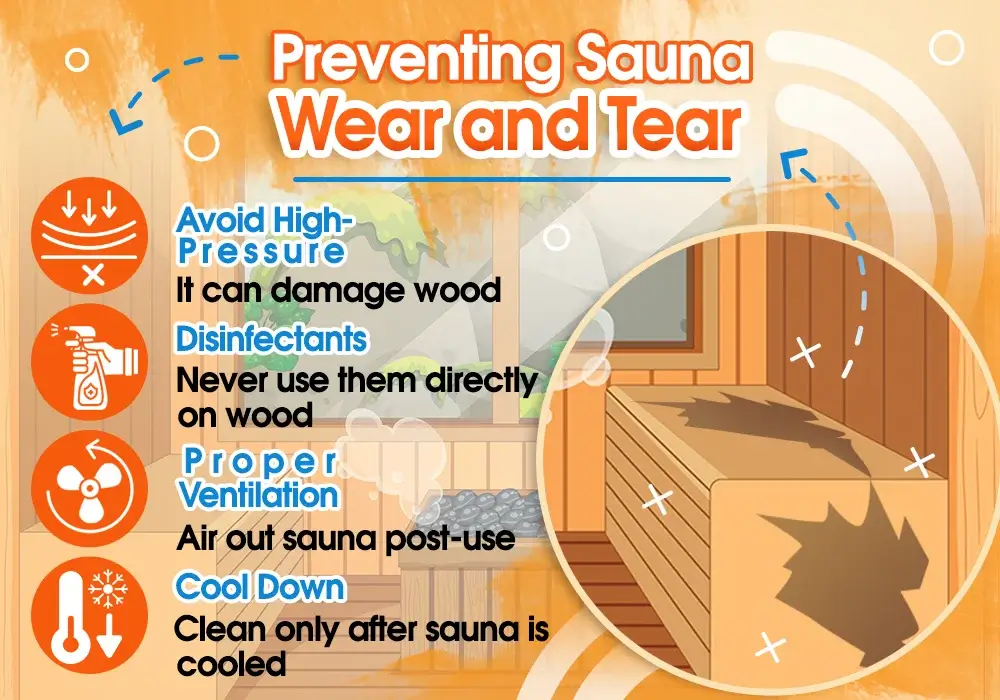This guide will cover everything from quick daily wipes to deep seasonal maintenance. We'll explore the specific needs of different sauna types and share safe, effective cleaning solutions you can use.
Why Sauna Cleaning is Non-Negotiable
A warm, moist environment is a welcome mat for bacteria, mold, and mildew. Without proper sauna cleaning, you risk compromising the very health benefits you seek.
Hygiene: Sweat, dead skin cells, and oils accumulate on surfaces. Regular cleaning removes this buildup, preventing the growth of germs and ensuring a hygienic space for you and your family. The heat of a sauna alone is not enough to sanitize surfaces where bacteria can thrive.
Longevity: Wood is the heart of most saunas. Sweat and moisture can stain and degrade the wood over time. Proper wood sauna maintenance protects it from damage, preventing warping, discoloration, and decay, which extends the life of your unit.
Safety: A neglected sauna can have slippery floors from accumulated residue. Additionally, dust and debris around the heater can pose a fire risk. Routine checks and cleaning keep the sauna operating safely.
Air Quality: A clean sauna simply smells better. Mold, mildew, and bacteria create musty odors that can ruin the relaxing atmosphere. Good steam room hygiene and regular cleaning ensure the air is fresh and inviting.
Your Sauna Cleaning Supplies Checklist
Before you start, gather your tools. Using the right supplies makes the job easier and safer for your sauna's surfaces.
Soft cloths or microfiber towels
A soft-bristle brush (never wire)
A bucket
Warm water
Mild, plant-based dish soap (unscented)
White vinegar
Baking soda
A spray bottle
Fine-grit sandpaper (150-grit or higher)
A handheld vacuum or brush and dustpan
Protective gloves

The After-Each-Session Reset (2 Minutes)
This quick routine is the most effective way to keep your sauna in great shape.
Wipe Down: Use a clean, damp cloth to wipe down benches, backrests, and any other surfaces you touched. This removes fresh sweat and oils before they can set into the wood.
Towel Up: Mop up any water or sweat puddles on the floor with a towel.
Air It Out: Leave the sauna door open and prop up duckboard flooring (if you have it) to allow air to circulate freely. This is the single best defense against mold and mildew.
The Weekly Deep Clean Routine (15-20 Minutes)
Set aside a little time each week for a more thorough clean. Always wait until the sauna is completely cool before starting.
Step-by-Step Instructions:
Clear the Deck: Remove any towels, duckboards, movable backrests, and heater stones (if they are cool and easily removable) from the sauna.
Vacuum Debris: Use a handheld vacuum or a brush and dustpan to remove all loose dirt, dust, and hair from the floor, benches, and corners.
Mix Your Solution: Fill a bucket with warm water and a very small amount of mild, unscented dish soap. For a natural disinfectant, you can create a solution of one part white vinegar to three parts water in a spray bottle.
Scrub the Benches and Backrests: Using a soft-bristle brush and your cleaning solution, gently scrub the benches and backrests. Pay extra attention to areas with visible sweat stains. Work with the grain of the wood.
Clean the Walls and Floor: Wipe down the walls with a cloth dampened with your cleaning solution. Scrub the floor, especially in high-traffic areas and corners.
Rinse Thoroughly: Use a clean cloth and fresh water to rinse all surfaces. It is critical to remove any soap or vinegar residue, which could release fumes when the sauna is heated. Avoid saturating the wood; a damp cloth is sufficient.
Dry and Ventilate: Towel-dry all surfaces and leave the door open for several hours to ensure everything dries completely before the next use.

Monthly and Quarterly Sauna Maintenance
These less frequent tasks keep your sauna in peak condition and prevent long-term issues.
Lightly Sand Wood Surfaces (As Needed): If you notice stubborn stains or the wood feels rough, you can lightly sand the benches and backrests with fine-grit sandpaper. Always sand with the grain. Vacuum the dust away afterward. This revitalizes the wood surface.
Check Your Heater and Stones (Quarterly): For traditional saunas, inspect your heater stones. According to guidance from health authorities like the Centers for Disease Control and Prevention (CDC) on water-related hygiene, preventing mineral buildup is key. Replace any cracked stones, as they can damage the heating elements. Rinse the stones with plain water to remove any dust or mineral deposits. Never use chemicals.
Inspect Drains and Gaskets (Quarterly): Ensure any floor drains are clear of debris. Check the door gasket for a tight seal to maintain heating efficiency and replace it if it appears worn or cracked.
Cleaning Different Types of Saunas: Dos and Don'ts
While the basics are similar, different saunas have unique needs.
Traditional Dry or Steam Saunas
Do: Pay close attention to the wood. The high heat and humidity make wood care paramount.
Do: Regularly check and clean heater stones to ensure efficient steam production and safety.
Don't: Ever splash water with cleaning solutions onto a hot heater.
Don't: Use harsh chemicals. When heated, their fumes can be toxic. Stick to simple soap, water, and vinegar solutions.
infrared saunas
Do: Focus on wiping down surfaces after each use. infrared saunas heat the body directly and often produce more sweat.
Do: Clean the infrared emitters. Use a dry, soft cloth to gently wipe dust off the carbon or ceramic panels when the sauna is cool and unplugged.
Don't: Spray liquids directly onto the heating elements or their protective covers. Apply your cleaner to a cloth first.
Don't: Use abrasive scrubbers on the emitters, as you could scratch or damage them. Proper care for these components is vital for clean infrared sauna performance.
Handling Common Sauna Cleaning Challenges
Even with regular maintenance, you might encounter a few issues. Here’s how to handle them.
Mold and Mildew Prevention
The best strategy is prevention. Always air out your sauna after use. If you spot small areas of mold or mildew, treat them immediately. A solution of one part white vinegar to three parts water is often effective. For more persistent spots, a diluted hydrogen peroxide solution can work, but test it on a hidden area first as it can lighten wood.
Deodorizing a Musty Sauna
A musty smell is a sign of moisture and bacteria. A deep clean is the first step. To absorb lingering odors, you can place a bowl of baking soda in the cool sauna overnight.
Sweat Stains and Tannin Discoloration
For fresh sweat stains, a quick scrub with warm water and a soft brush usually works. For older, darker stains, gently sanding the area may be necessary. Sometimes, wood releases natural tannins that can cause discoloration. This is normal and often can be cleaned with a mild wood cleaner or sanded away.
What to Never Use When Cleaning Your Sauna
Using the wrong products can cause permanent damage to your sauna and create a hazardous environment.
Harsh Chemicals: Never use bleach or ammonia-based cleaners on sauna wood. They will damage the wood fibers, cause discoloration, and release toxic fumes when heated. The Environmental Protection Agency (EPA) offers a "Safer Choice" program to help identify products with safer chemical ingredients.
Oils or Varnishes: Do not apply stain, varnish, or oils to the interior wood of your sauna. These sealants can make surfaces dangerously hot and release harmful chemicals when heated. The natural wood is meant to breathe.
Pressure Washers: The high-pressure stream will damage the soft wood fibers and force water deep into the boards, leading to rot and mold.

Safety and Sustainability in Your Cleaning Routine
A wellness practice should be safe for you and the planet.
Safety Precautions
Cool Down First: Always ensure the sauna is completely cool and turned off (or unplugged) before you begin cleaning.
Ventilate: Keep the door open and ensure good airflow while you clean, especially if using vinegar.
Use Protective Gear: Wear gloves to protect your hands from dirt and cleaning solutions.
For guidance on safe handling of disinfectants, you can refer to resources from organizations like the World Health Organization (WHO).
Sustainable Cleaning Tips
Conserve Water: Use a bucket and cloth rather than a running hose.
Choose Microfiber: High-quality microfiber cloths are highly effective and can be washed and reused for years.
Go Fragrance-Free: Avoid synthetic fragrances, which can be irritating and unnecessary. The natural scent of clean cedar or hemlock is what you want.

Your Path to a Pristine Sauna
Maintaining your sauna doesn't have to be complicated. By integrating a quick post-session wipe-down into your routine and committing to a weekly deep clean, you ensure your personal oasis remains a clean, safe, and deeply restorative space. This commitment to sauna cleaning protects your investment and, more importantly, enhances your path to wellness. A well-cared-for sauna will reward you with relaxation and rejuvenation for many years to come.



